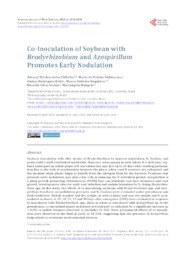Co-inoculation of soybean with Bradyrhizobium and Azospirillum promotes early nodulation.
Co-inoculation of soybean with Bradyrhizobium and Azospirillum promotes early nodulation.
Author(s): CHIBEBA, A. M.; GUIMARÃES, M. de F.; BRITO, O. R.; NOGUEIRA, M. A.; ARAUJO, R. S.; HUNGRIA, M.
Summary: Soybean inoculation with elite strains of Bradyrhizobium to improve nodulation, N2 fixation, and grain yield is well established worldwide. However, when grown in soils where N is deficient, soybean undergoes an initial phase of N starvation that may last up to 20 days after seedling germination due to the lack of synchronism between the phase when seed N reserves are exhausted and the moment when plants begin to benefit from the nitrogen fixed by the bacteria. Practices that promote early nodulation may play a key role in reducing the N starvation period. Azospirillum is a plant growth promoting rhizobacteria (PGPR) that can stimulate root hair formation and root growth, creating more sites for early root infection and nodule formation by N2-fixing Bradyrhizobium spp. In this study, the effects of co-inoculating soybeans with Bradyrhizobium spp. and Azospirillum brasilense on nodulation precocity and N2 fixation were evaluated under greenhouse and field conditions. Nodule number and dry weight, as well as plant and root dry weight and N accumulated in shoots at 15, 18, 21, 24 and 30 days after emergence (DAE) were evaluated in response to inoculation with Bradyrhizobium spp. alone or when co-inoculated with Azospirillum sp. In the greenhouse, co-inoculated plants nodulated precociously as indicated by a significant increase (p< 0.05) in nodule biomass observed at (include) 21 DAE. More pronounced effects of co-inoculation were observed in the field as early as 18 DAE, suggesting that the presence of Azospirillum helps plants to overcome environmental stresses.
Publication year: 2015
Types of publication: Journal article
Unit: Embrapa Soybean
Keywords: Fixação de nitrogênio, Inoculante, Nitrogen fixation, Soja, Soybeans
Observation
Some of Embrapa's publications are published as ePub files. To read them, use or download one of the following free software options to your computer or mobile device. Android: Google Play Books; IOS: iBooks; Windows and Linux: Calibre.
Access other publications
Access the Agricultural Research Database (BDPA) to consult Embrapa's full library collection and records.
Visit Embrapa Bookstore to purchase books and other publications sold by Embrapa.

